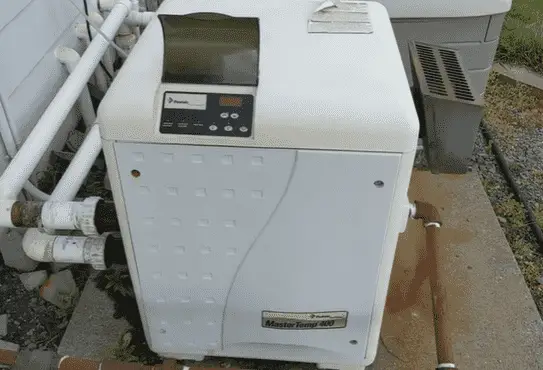The problem of Pentair MasterTemp 400 not heating can be caused by a faulty temperature sensor, broken manifold bypass valve, bad thermal regulator, insufficient water flow rate, faulty heat exchanger, inter bypass open, and insufficient gas pressure.
Keep scrolling and read our Pentair MasterTemp 400 troubleshooting guide to fix your heater ASAP.
Table Of Contents
- Pentair MasterTemp 400 Not Heating [7 Easy Fixes]
- 1. Faulty Temperature Sensor
- 2. Broken Manifold Bypass Valve
- 3. Bad Thermal Regulator
- 4. Insufficient Flow Rate
- 5. Faulty Heat Exchanger
- 6. Open Internal Bypass
- 7. Insufficient Gas Pressure
- FAQs
- Where is the stack flue sensor located?
- What does the E05 error mean?
- Should I have a bypass for my pool heater?
- How to activate the control panel lockout?
- Can chlorine damage the pool heater?
- Conclusion
Pentair MasterTemp 400 Not Heating [7 Easy Fixes]
In this section, we will take an in-depth look at the causes behind your Pentair MasterTemp 400 not heating. We will also provide the simplest solution for each of the issues.
1. Faulty Temperature Sensor
The temperature sensor’s job is to read the water temperature to see whether the desired temperature has been reached.
If it is getting incorrect readings that are higher than the actual temperature, your heater will stop heating thinking that the water has reached the set temperature.
Solution:
A multimeter can be used to test the sensor. At 77 degrees Fahrenheit (25 degrees Celsius), it should read 10,000 ohms. In the Temperature vs Resistance Conversion Chart for 10k Thermistors, you can search for various test values.
You need to replace the temperature sensor if it is broken. Watch this video for instructions on Pentair MasterTemp 400 temperature sensor replacement.
2. Broken Manifold Bypass Valve
A bypass directs water flow around the heater rather than through it, preventing it from passing through.
A broken manifold bypass valve can cause the water to completely bypass the heater’s heating coils and be poured back into the pool.
Solution:
Your manifold bypass, as well as the gasket, must be replaced. Manifold replacement is a straightforward procedure.
Remove the front and back panels, the side cover for the manifold, and the bolts that hold the manifold in place. Bolts from the manufacturer may be coated with red high-temperature Permatex. Remove it using a scraper.
A screwdriver and a hammer are required to disassemble the manifold assembly. Replace the old manifold with the new one.
Tighten the bolts in alternating directions to re-compress all of the o-rings and gaskets. On a motor, torquing head nuts is similar.
3. Bad Thermal Regulator
The Thermal Regulator controls the flow of water to make sure that the Heat Exchanger Outlet temperature is above 120 degrees Fahrenheit. A faulty thermistor might result in water, not heating.
Solution:
By removing the thermal regulator, you may check for continuity. The Thermal Regulator is situated between the inlet and outlet connections in the Inlet/Outlet Manifold, behind the threaded plug.
Fit a regular screwdriver into the plug’s threads and twist the hold to unscrew it. Keep doing so until both the plug and the thermal regulator are removed.
Half-fill a jar with 130°F water. Submerge the thermal regulator in water to test if it opens. If it opens, you have a functioning temperature regulator.
You can double-check the thermal regulator by re-immersing it in cold water. It should close again if the device is in proper functioning order. If the test indicates a problem, replace the thermistor.
4. Insufficient Flow Rate
The pace at which heat rises from the intake to the outlet is determined by the water flow rate.
The heat rise should be 16.8 degrees at 40 GPM, which is the minimum acceptable flow rate for Pentair MasterTemp 400. So. an insufficient water flow can result in water not heating.
Solution:
A blockage in your pool heating system can reduce water flow in your heater. Make sure your pool filter is in good working order.
Remove the baskets and empty them. Check to see if the pump is delivering enough water to the system.
5. Faulty Heat Exchanger
The heat exchanger allows the transfer of heat. When your heat exchanger is faulty, it may cause your heater to not adequately heat water.
Solution:
The heat exchanger must be checked to see if it is damaged. With the Flameholder removed, a flashlight and mirror can be used to perform a partial inspection of the heat exchanger’s inward-facing surfaces.
Remove the heat exchanger from the unit for thorough verification. You need to replace the entire heat exchanger if any of the heat exchanger tubes are damaged.
6. Open Internal Bypass
The water flow through the heat exchanger is regulated by a thermal regulator and the internal bypass to maintain the proper exit temperature. If the bypass is stuck open, water won’t flow and get heated.
Solution:
You may need to replace the internal bypass to fix this issue. Here’s how you do it.
Step 1: Turn off the filter pump as well as the heater’s electrical power. Close the Manual Gas Valve on the outside. If the heater is below the pool’s water level, close the isolation valves to prevent the pool from draining.
Step 2: Drain the heater by opening the Pressure Relief Valve. To gain access to the Bypass Access Plug, remove any coverings, doors, or panels.
Step 3: To open the Bypass Access Plug, crank the Pipe Plug Tool counter-clockwise with a 7/8″ open-end wrench or an adjustable wrench. The Internal Bypass Valve is now available to you.
Step 4: Remove the internal bypass valve and reverse steps 1-3 to reassemble the manifold bypass access plug.
7. Insufficient Gas Pressure
Your Pentair MasterTemp 400 may be unable to heat the water due to a lack of sufficient gas pressure.
Solution:
Perform the following tests to determine the gas pressure.
Step 1: Begin by removing the back panel. Remove the four screws with a 38-inch nut driver. Remove the panel by lifting it up. You should be able to locate the gas valve to the right.
Step 2: Remove the small plug on the side of the gas valve with a 3/16 inch Allen wrench. Connect a manometer to the gas valve once it has been turned off. To begin, you’ll need to insert an adapter.
Step 3: Connect the hose to the gas valve and turn it on. Have a look at the pressure gauge. For your Pentair heater, a measurement of 10 inches of the water column is optimum.
Step 4: Turn on the heating. You don’t have enough gas pressure if your gas pressure decreases more than 1-2″ of the water column when it fires.
For assistance, call your local gas company.
FAQs
Where is the stack flue sensor located?
You can locate the Indoor Stack Flue Switch of your Pentair MasterTemp 400 at the Exhaust Elbow. The Stack Flue Sensor ensures that the flue gas production does not exceed 500°F.
What does the E05 error mean?
It means that the ignition has failed, as indicated by the ‘E05 diagnostic code. In many circumstances, the heater will start and heat for a few minutes before turning off. Typically, a poor igniter is to blame, however, this isn’t always the case.
Should I have a bypass for my pool heater?
Yes. At times you may need to redirect water flow away from the pool heater. For example- when the heater has a leak or has to be repaired, balancing the water chemistry and opening the pool in the spring, or during hot summers.
How to activate the control panel lockout?
To activate the control panel lockout, simultaneously press the MENU SELECT and MODE buttons. To unlock the control panel, simultaneously press the MENU SELECT and MODE buttons.
Can chlorine damage the pool heater?
Yes, to a point it does damage your pool heater. Chlorine destroys rubber and corrodes pool cleaners, pumps, and filter plastic parts. It can also harm the internals of pool heaters, as well as valves and rubber seals. This type of damage can be rather costly.
Conclusion
Hopefully, you can now take care of matters when the Pentair MasterTemp 400 not heating issue takes place. If you have other issues with your heater, read our article on Pentair MasterTemp 400 common problems.

